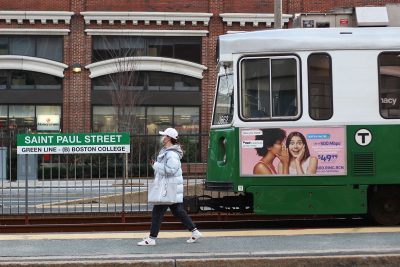The sound of the T honking at a student crossing Commonwealth Avenue may become more rare by 2021.
The Massachusetts Bay Transportation Authority’s Fiscal Management and Control Board granted a $17.8 million contract Monday to consolidate four Green Line B Branch stops along Commonwealth Avenue into two.

The St. Paul Street and Boston University West stations, as well as the Babcock Street and Pleasant Street stations, will be replaced with two new stations to speed up service, according to an MBTA press release. The consolidation is a major part of the Green Line Transformation project.
Each of the completed stations would also offer new benches, shelters and safety features. At both stations, the project would implement updated fare collection machines, longer platforms and low-level vehicle compatibility for boarding and exiting.
Construction for the new platforms will begin in 2020, with a projected completion date of 2021, according to the MBTA.
MBTA General Manager Steve Poftak said in a press release the consolidation will be advantageous to commuters in various ways, including more consistent timing, faster rides and increased accessibility.
“While customers will be able to experience these benefits by the fall of 2021,” Poftak said, “these improvements also set the stage for the transformation of the Green Line as the new stations’ larger platforms will accommodate the new longer cars in procurement for the Green Line.”
Stacy Thompson, director of transit advocacy group LiveableStreets Alliance, said she has been an advocate of this change for years.
“We are very supportive of stop consolidation,” Thompson said. “When stop consolidation is done properly, it can really speed up service and make for a better overall experience for the folks who are waiting for the train and the folks who are riding it.”
This consolidation comes after a long-debated push for faster transportation. Thompson attributes some of the pushback against consolidation to the more difficult nature of working with trains rather than buses.
“Stop consolidation on a rail line versus the bus line is just technically more complicated,” Thompson said. “So it requires just a level of work that’s a little different than that of bus stop consolidation.”
Thompson said part of the hesitation might also be because stop consolidations aren’t always convenient for everyone.
“People always want it to be someone else’s stop that’s consolidated,” Thompson said. “Everyone wants to train to go faster when they’re on it. But that means they might have to walk a block or two farther than they’re currently walking in order to get to a consolidated stop.”
While decreasing the frequency of stops might pose inconveniences to those who are physically disabled, Thompson said there likely will not be a drastic impact on those who take the Green Line.
“Transit is always about trade-offs and about balancing needs and priorities,” Thompson said. “But given that the population that utilizes the line, particularly where the consolidation is happening, is largely student-based, is largely younger and largely is not facing mobility issues … this overall seems like the right set of trade-offs to make.”
However, Thomspon said that stop consolidations must be mindful of communities that could be harmed.
“It’s always important to consider those populations and to make sure that if there is a different impact, there is some sort of mitigation involved to make sure that everyone is still being served by transit,” Thompson said.
Although the project presents a seemingly minor change in overall transit times and longer walks between stops, Thompson said these new stations will provide substantial change.
“Every one of those stops is a minute and a half of someone’s time,” Thompson said. “Then you multiply that by five days a week, and all of a sudden you have multiple Netflix shows you could have been watching or all those dinner parties you could have been going to in the time that you wasted just sitting on the T.”














